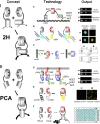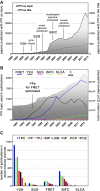Techniques for the Analysis of Protein-Protein Interactions in Vivo
- PMID: 27208310
- PMCID: PMC4902627
- DOI: 10.1104/pp.16.00470
Techniques for the Analysis of Protein-Protein Interactions in Vivo
Abstract
Identifying key players and their interactions is fundamental for understanding biochemical mechanisms at the molecular level. The ever-increasing number of alternative ways to detect protein-protein interactions (PPIs) speaks volumes about the creativity of scientists in hunting for the optimal technique. PPIs derived from single experiments or high-throughput screens enable the decoding of binary interactions, the building of large-scale interaction maps of single organisms, and the establishment of cross-species networks. This review provides a historical view of the development of PPI technology over the past three decades, particularly focusing on in vivo PPI techniques that are inexpensive to perform and/or easy to implement in a state-of-the-art molecular biology laboratory. Special emphasis is given to their feasibility and application for plant biology as well as recent improvements or additions to these established techniques. The biology behind each method and its advantages and disadvantages are discussed in detail, as are the design, execution, and evaluation of PPI analysis. We also aim to raise awareness about the technological considerations and the inherent flaws of these methods, which may have an impact on the biological interpretation of PPIs. Ultimately, we hope this review serves as a useful reference when choosing the most suitable PPI technique.
© 2016 American Society of Plant Biologists. All Rights Reserved.
Figures







References
-
- Adjobo-Hermans MJ, Goedhart J, Gadella TW Jr (2006) Plant G protein heterotrimers require dual lipidation motifs of Galpha and Ggamma and do not dissociate upon activation. J Cell Sci 119: 5087–5097 - PubMed
-
- Albert I, Bohm H, Albert M, Feiler CE, Imkampe J, Wallmeroth N, Brancato C, Raaymakers TM, Oome S, Zhang HQ, et al. (2015) An RLP23-SOBIR1-BAK1 complex mediates NLP-triggered immunity. Nat Plants 1: 15140. - PubMed
Publication types
MeSH terms
Substances
LinkOut - more resources
Full Text Sources
Other Literature Sources
Research Materials
Miscellaneous

